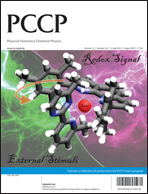Shifts in the temperature of maximum density (TMD) of ionic liquid aqueous solutions†
Abstract
This work investigates for the first time shifts in the temperature of maximum density (TMD) of water caused by ionic liquid solutes. A vast amount of high-precision volumetric data—more than 6000 equilibrated (static) high-precision density determination corresponding to ∼90 distinct ionic liquid aqueous solutions of 28 different types of ionic liquid—allowed us to analyze the TMD shifts for different homologous series or similar sets of ionic solutes and explain the overall effects in terms of hydrophobic, electrostatic and hydrogen-bonding contributions. The differences between the observed TMD shifts in the −2 < t/°C < 4 range and salting-in or salting-out effects produced by the same type of ions in aqueous solutions at higher temperatures are discussed taking into account the different types of possible solute–water interactions that can modify the structure of the aqueous phase. The results also reveal different insights concerning the nature of the ions that constitute typical ionic liquids and are consistent with previous results that established hydrophobic and hydrophilic scales for ionic liquid ions based on their specific interactions with water and other probe molecules.


 Please wait while we load your content...
Please wait while we load your content...